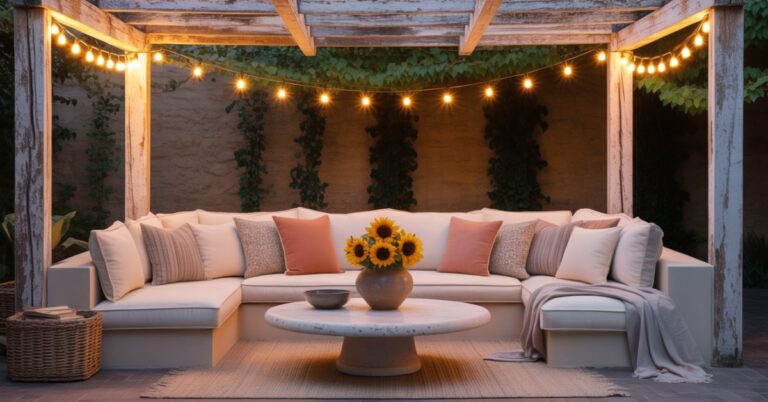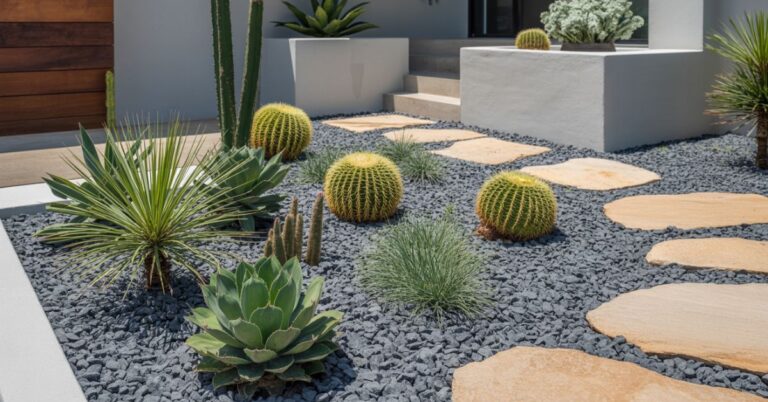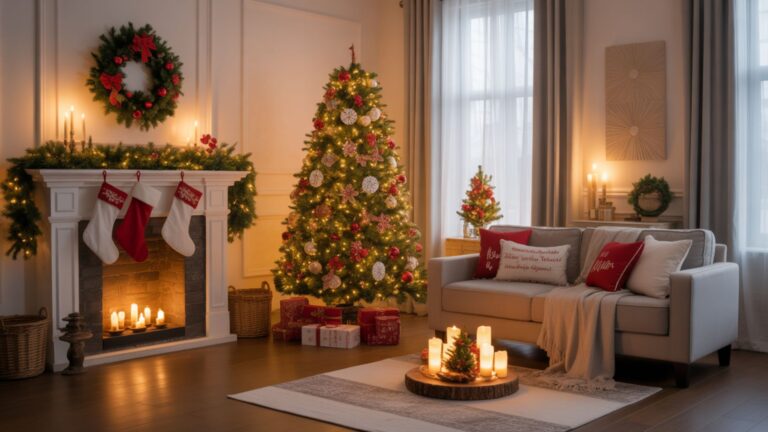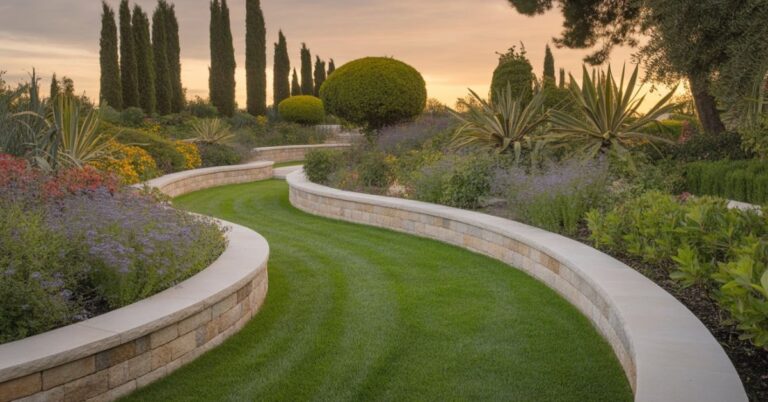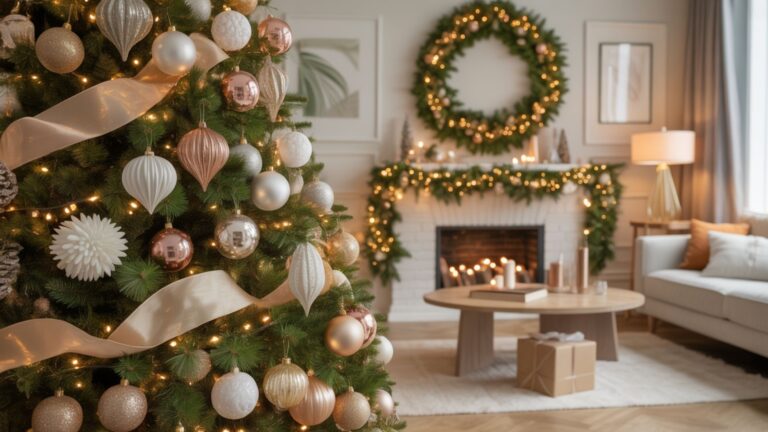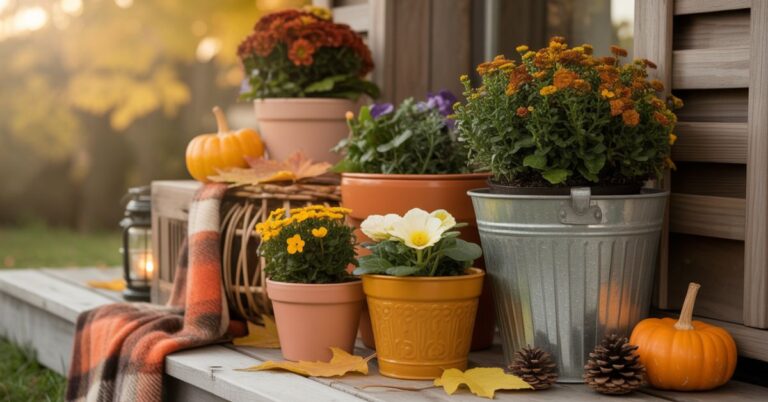35 Low Light Plants for Living Room
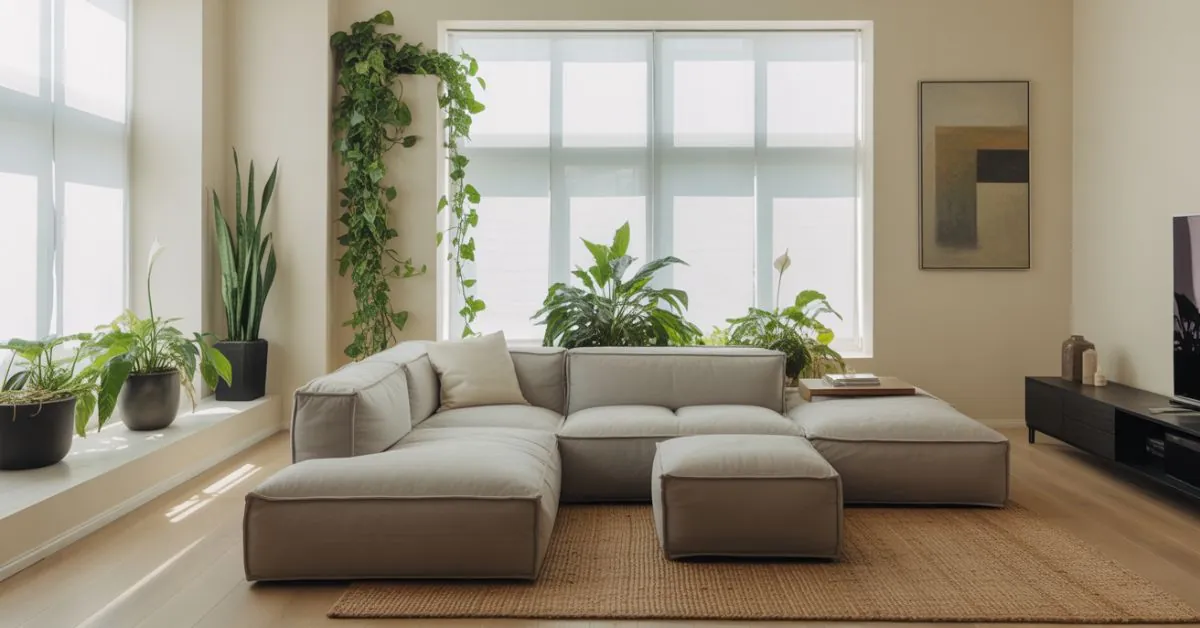
Picture this: you’re sitting in your living room, surrounded by lifeless furniture and sterile walls, desperately wishing you could add some natural beauty but convinced your dimly lit space is a plant graveyard waiting to happen. Sound familiar? Millions of homeowners face this exact dilemma, watching expensive plants slowly wither away in their poorly lit spaces. Without the right greenery, the room feels dull and uninspired, leaving many convinced they’ll never achieve that Instagram-worthy indoor jungle. The harsh reality is that most popular houseplants demand bright, direct sunlight that many living rooms simply cannot provide. That’s why Low Light Plants for Living Room décor have become the go-to solution for anyone who wants greenery that thrives even in dim spaces.
However, here’s the transformative truth: dozens of stunning Low Light Plants for Living Room not only survive but absolutely thrive in shaded corners. These versatile Low Light Plants for Living Room design ideas create lush, sophisticated interiors that impress every visitor. Even better, Low Light Plants for Living Room arrangements require surprisingly little maintenance, making them the ultimate choice for homeowners who long to transform a dull corner into a vibrant green sanctuary without the struggle of constant care.
Read More About: Low Light House Plants for Gardens in Dim Spaces
What Makes Living Room Lighting Challenging for Plants?
Living rooms present unique indoor plant lighting challenges due to their typical design and layout requirements. Most living spaces prioritize comfort and entertainment over natural light, featuring large furniture pieces that block window access, heavy window treatments for privacy, and entertainment centers positioned away from light sources. For this reason, homeowners often turn to Low Light Plants for Living Room décor to bring greenery into spaces where natural light is limited.
North-facing living rooms receive consistent but gentle indirect light throughout the day, making them ideal for shade-tolerant houseplants. These environments are perfect for Low Light Plants for Living Room arrangements that thrive in indirect light. In contrast, south-facing spaces often have furniture arrangements that create shadowy corners, which are better suited for Low Light Plants for Living Room rather than sun-loving species.
Modern architecture frequently incorporates energy-efficient windows and open floor plans that distribute available light across larger areas, reducing intensity levels. In these conditions, only Low Light Plants for Living Room displays can truly flourish, making plant selection a key design consideration. Understanding these limitations helps homeowners choose appropriate species rather than fighting against their space’s natural conditions.
Artificial lighting from table lamps, floor lamps, and overhead fixtures creates additional growing opportunities for living room plants. LED bulbs and fluorescent lighting can support Low Light Plants for Living Room, extending viable growing areas far beyond natural window light zones and giving homeowners more flexibility in their plant styling.
Best Low Light House Plants for Living Room Corners
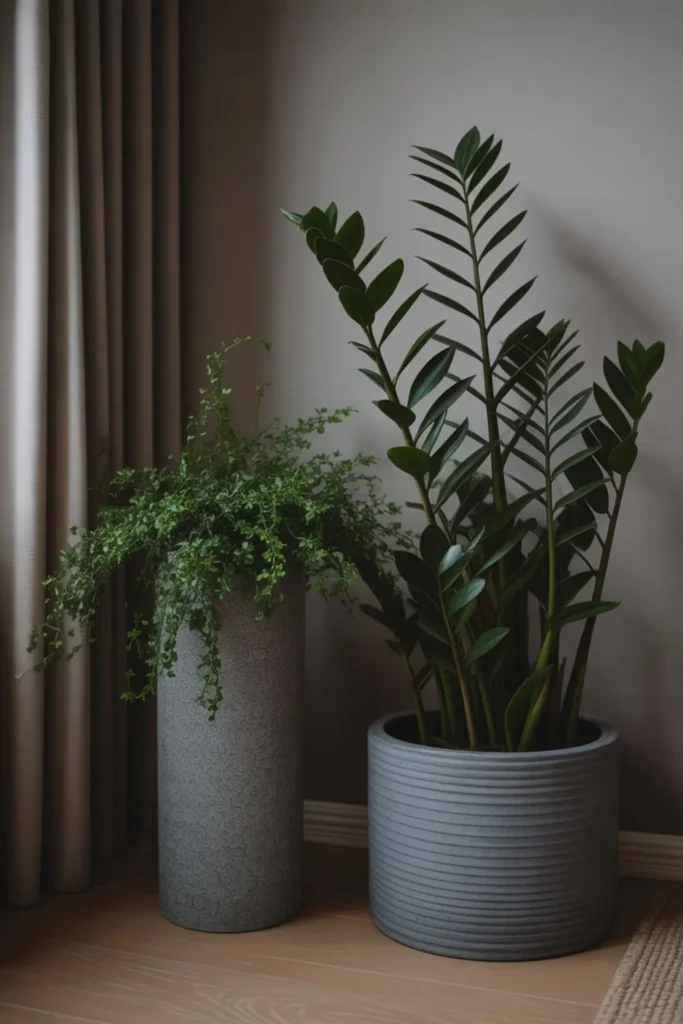
Monstera Deliciosa
The Monstera Deliciosa stands as the ultimate living room statement plant, with its dramatic split leaves and architectural form that commands attention in any space. This plant’s unique leaves make it a popular choice for home decor, while it also purifies the air and is drought-tolerant, making it perfect for busy homeowners who want maximum visual impact with minimal effort.
Corner placement allows Monstera plants to develop their natural climbing habit while their large foliage fills empty vertical space effectively. These tropical houseplants adapt to medium to low light conditions while developing increasingly dramatic leaf fenestrations as they mature, creating living sculptures that evolve over time.
Fiddle Leaf Fig
Fiddle Leaf Figs bring contemporary elegance to living rooms with their glossy, violin-shaped leaves and upright growth pattern. While often considered high-light plants, they adapt surprisingly well to bright indirect light conditions typical of living room corners positioned near windows.
Placement strategy involves positioning these designer plants in areas receiving filtered natural light for 4-6 hours daily. Their sculptural appearance makes them perfect floor plants that serve as natural room dividers or accent pieces beside modern furniture.
Rubber Tree
Rubber trees offer glossy burgundy or deep green foliage that creates sophisticated color contrast in neutral living room color schemes. These low maintenance houseplants tolerate low to medium light while developing into impressive floor specimens that anchor seating areas beautifully.
Burgundy Rubber Trees add dramatic color depth without overwhelming minimalist decor, while their thick, waxy leaves require minimal dusting and maintenance. Compact varieties work well as tabletop plants on coffee tables or side tables.
How Do You Style Low Light House Plants in Living Room Decor?
Modern Minimalist Approaches
Contemporary plant styling emphasizes clean lines and architectural plant forms that complement modern furniture without creating visual clutter. Using Low Light Plants for Living Room in single-statement arrangements allows homeowners to add greenery that thrives in dim conditions while creating elegant focal points. Statement Low Light Plants for Living Room in neutral containers draw attention without overwhelming minimalist aesthetics, making every plant a design highlight.
Geometric planters in matte black, white ceramic, or natural wood provide versatile backgrounds that showcase textures of Low Light Plants for Living Room, maintaining design coherence across the space. Floor planters with built-in saucers protect flooring while seamlessly integrating Low Light Plants for Living Room into contemporary décor.
Thoughtful use of negative space allows Low Light Plants for Living Room silhouettes to create striking visual interest against plain walls or large windows. This styling approach emphasizes plant architecture rather than dense collections, turning Low Light Plants for Living Room into sophisticated, intentional displays that enhance modern living spaces without clutter.
Bohemian and Eclectic Styling
Boho plant arrangements embrace layered textures and varied heights to create lush, jungle-like atmospheres, making Low Light Plants for Living Room an ideal choice for dim corners. Hanging planters, plant stands, and floor specimens filled with Low Light Plants for Living Room work together to occupy vertical space while creating cozy, lived-in vibes.
Macrame plant hangers and woven baskets add textural interest while supporting trailing Low Light Plants for Living Room such as Pothos and Philodendrons. Vintage furniture pieces repurposed as plant stands elevate Low Light Plants for Living Room, providing both charm and practical growing positions for plants that thrive in low light conditions.
Color coordination through planter selection ties diverse Low Light Plants for Living Room collections together visually. Warm earth tones, natural materials, and handcrafted containers not only enhance bohemian aesthetics but also create suitable growing environments for Low Light Plants for Living Room, ensuring they flourish even in dimly lit spaces.
Traditional and Classic Arrangements
Formal plant arrangements utilize symmetrical placement and classic container styles to complement traditional furniture and architectural details. Matching pairs of plants flanking fireplaces or entryways create balanced compositions that feel established and elegant.
Ceramic planters in classic shapes and neutral glazes provide timeless appeal that won’t conflict with changing decor trends. Pedestal stands and plant tables create elevated displays that integrate with traditional furniture heights.
Seasonal styling allows plant arrangements to evolve throughout the year while maintaining classic foundations. Decorative elements like seasonal ribbons or holiday ornaments can transform permanent plant displays for special occasions.
Which Low Light House Plants Work Best on Living Room Tables?
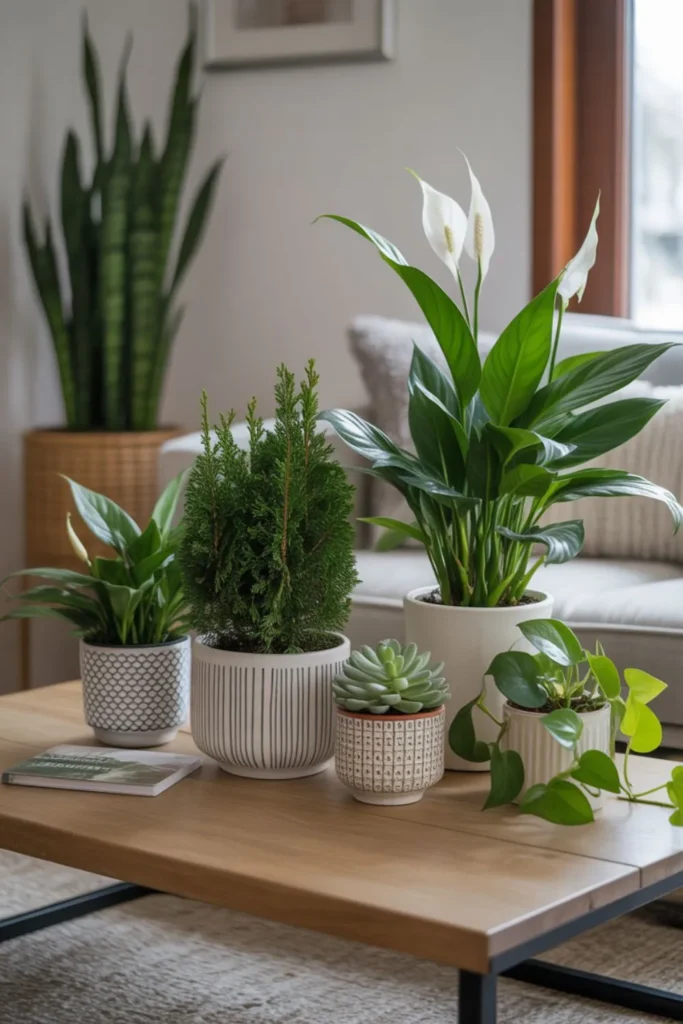
Coffee Table Centerpieces
Coffee table plants must balance visual impact with practical functionality, making Low Light Plants for Living Room the perfect choice for these high-traffic areas. Avoid tall specimens that block conversation or wide spreads that interfere with daily use. Compact Low Light Plants for Living Room varieties like Chinese Money Plants and small Philodendrons provide greenery without overwhelming table surfaces.
Pilea Peperomia, with its round, coin-shaped leaves, is a standout example of Low Light Plants for Living Room that thrives in indirect light. This Chinese Money Plant requires minimal care, making it ideal for busy living rooms where low-maintenance greenery is essential. Propagating Low Light Plants for Living Room like Pilea also creates thoughtful gift opportunities for friends who love indoor plants.
Shallow containers and wide planters perfectly complement coffee table proportions while supporting healthy root development for Low Light Plants for Living Room. Built-in water trays prevent surface damage and make watering convenient, ensuring your Low Light Plants for Living Room remain vibrant and stylish without any hassle.
Side Table Accents
Side table plants create intimate green spaces beside reading chairs and sofas while filling awkward vertical spaces between furniture pieces. Medium-height plants like Peace Lilies and Chinese Evergreens provide visual weight without blocking lamp light or table functionality.
Snake Plant varieties work exceptionally well on side tables due to their upright growth and minimal footprint. Their architectural leaves create vertical interest while their low water requirements suit occasional table use.
Decorative cache pots allow easy seasonal container changes while protecting furniture surfaces from moisture damage. Matching sets throughout living rooms create design continuity while supporting plant health.
Console and Entertainment Center Plants
Console table styling benefits from trailing plants that soften hard edges while cascading foliage creates dynamic movement around static furniture. Pothos varieties and Heartleaf Philodendrons provide flexible styling options that adapt to changing arrangements.
Entertainment center integration requires heat-tolerant plants positioned away from electronic equipment. ZZ Plants and Cast Iron Plants handle temperature fluctuations from media components while their architectural forms complement modern electronics.
Cable management considerations affect planter placement around entertainment areas. Elevated plant stands keep foliage away from power cords while creating visual separation between natural elements and technology.
How Do You Create Living Room Plant Arrangements That Purify Air?
NASA-Approved Air Purifying Species
Air purifying houseplants provide measurable health benefits while creating beautiful living room displays. Snake Plants, Peace Lilies, and Spider Plants consistently rank among NASA’s recommended species for removing common indoor pollutants like formaldehyde and benzene.
Formaldehyde removal becomes particularly important in new furniture environments where off-gassing creates indoor air quality issues. Peace Lilies excel at chemical filtration while their white blooms add elegant beauty to formal living spaces.
Benzene absorption benefits homes with attached garages or urban locations where automotive pollutants infiltrate indoor environments. Spider Plants provide exceptional filtering capacity while their cascading plantlets create dynamic visual interest.
Optimal Plant Density for Air Cleaning
Effective air purification requires strategic placement of Low Light Plants for Living Room and adequate plant density throughout living spaces. Research suggests that one large Low Light Plant for Living Room or 2–3 smaller specimens per 100 square feet provides meaningful air-cleaning benefits without overwhelming design aesthetics.
Circulation considerations directly affect plant effectiveness, as air movement helps distribute purified air throughout rooms. Low Light Plants for Living Room positioned near return air vents or natural airflow paths maximize filtering efficiency, while corner placements with limited air circulation may reduce their impact.
Seasonal adjustments in plant density ensure that Low Light Plants for Living Room continue to support air quality needs throughout the year. During winter months, when homes remain sealed, adding additional Low Light Plants for Living Room enhances air cleaning, while summer periods with increased ventilation may require fewer plants to maintain optimal indoor air quality.
Combining Plants for Maximum Benefits
Synergistic plant combinations utilize different species’ specialized filtering capabilities to address multiple pollutant types simultaneously. Complementary plant partnerships create comprehensive air cleaning systems while maintaining design harmony.
Day and night air purification benefits from combining traditional plants that work during daylight hours with CAM plants like Snake Plants that continue air processing during evening hours. This 24-hour coverage maximizes health benefits.
Aesthetic plant groupings can incorporate diverse air purifying species without sacrificing design coherence. Similar container styles and coordinated plant heights create unified displays while providing varied air cleaning capabilities.
What Are the Best Low Light House Plants for Different Living Room Styles?
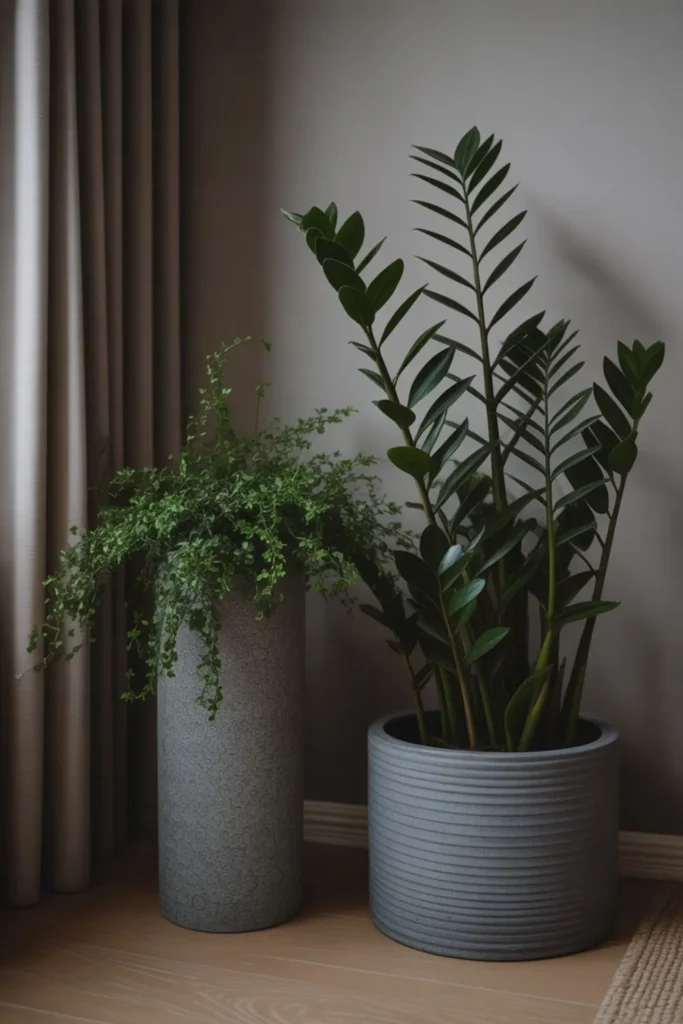
Contemporary and Modern Living Rooms
Modern living room designs emphasize architectural forms and sculptural qualities, making Low Light Plants for Living Room an ideal choice for spaces with clean lines and minimalist aesthetics. Varieties like ZZ Plants and Snake Plants serve as Low Light Plants for Living Room that provide geometric shapes echoing contemporary furniture while requiring minimal maintenance.
Color palette coordination highlights Low Light Plants for Living Room with dark green foliage or striking variegation, perfectly complementing the neutral color schemes typical of modern interiors. Burgundy Rubber Trees, for instance, add sophisticated color depth as Low Light Plants for Living Room without overwhelming restrained palettes.
Container selection for Low Light Plants for Living Room focuses on geometric shapes in industrial materials such as concrete, metal, or sleek ceramics. Built-in planters and custom installations integrate Low Light Plants for Living Room seamlessly with architectural elements, creating a cohesive, stylish living environment.
Farmhouse and Rustic Decor
Farmhouse plant styling embraces natural containers and cottage-garden aesthetics that complement rustic furniture and vintage accessories. Galvanized buckets, wooden boxes, and wicker baskets provide authentic container options for country-style arrangements.
Plant selection emphasizes traditional houseplant varieties like Cast Iron Plants and Parlor Palms that evoke historical indoor gardening. These heritage species provide authentic period character while thriving in typical farmhouse lighting conditions.
Seasonal decoration allows farmhouse plant displays to evolve with holiday celebrations and agricultural cycles. Natural materials like burlap ribbons, wooden plant markers, and seasonal branches create festive arrangements throughout the year.
Scandinavian and Hygge Aesthetics
Scandinavian plant styling prioritizes simplicity, natural materials, and cozy comfort that supports hygge principles. Light wood containers and neutral ceramics complement Nordic color palettes while trailing plants create soft, organic shapes.
Plant placement emphasizes natural light utilization and seasonal adaptation that reflects Scandinavian environmental awareness. Window positioning maximizes limited daylight during winter months while flexible arrangements adapt to changing seasons.
Sustainable practices align with Scandinavian values through propagation, composting, and natural fertilizers. DIY plant projects and handmade containers create personal connections with indoor gardens while supporting environmental consciousness.
How Do You Maintain Low Light House Plants in High-Traffic Living Areas?
Protecting Plants from Foot Traffic and Pets
High-traffic plant placement requires strategic positioning that avoids collision zones while maintaining design effectiveness. Corner placements and elevated positions protect plants from accidental damage while floor-level specimens need adequate clearance from walking paths.
Pet-safe plant selections become crucial in family living rooms where cats and dogs interact with indoor plants. Spider Plants, Boston Ferns, and Parlor Palms provide safe options that won’t harm curious pets while maintaining attractive appearances.
Physical protection through decorative barriers or plant stands prevents accidental damage without compromising aesthetic appeal. Wraparound planters and raised containers create natural boundaries while supporting healthy plant growth.
Dust Management in Living Spaces
Living room dust accumulation affects plant health by blocking light absorption and reducing photosynthesis efficiency. Weekly dusting with microfiber cloths or gentle shower rinses maintains optimal leaf function while preserving attractive appearances.
Air circulation improvement through ceiling fans and natural ventilation reduces dust settlement while supporting plant health. HEPA air purifiers complement plant air cleaning while reducing maintenance requirements.
Plant selection considers leaf texture and dust retention characteristics when choosing species for high-dust environments. Glossy-leaved plants like Rubber Trees and Peace Lilies clean more easily than fuzzy-leaved varieties.
Watering and Care in Busy Households
Simplified watering schedules accommodate busy family lifestyles through drought-tolerant plant selection and water-efficient care routines. Monthly watering suffices for many low light species, reducing maintenance pressure on active households.
Self-watering systems provide consistent moisture without daily attention, making them ideal for vacation periods and irregular schedules. Water reservoirs and capillary systems maintain optimal soil moisture automatically.
Family involvement in plant care creates shared responsibility while teaching children about nature and environmental stewardship. Age-appropriate tasks like misting and leaf cleaning encourage plant appreciation without overwhelming young helpers.
What Are the Most Common Mistakes When Growing Living Room Plants?
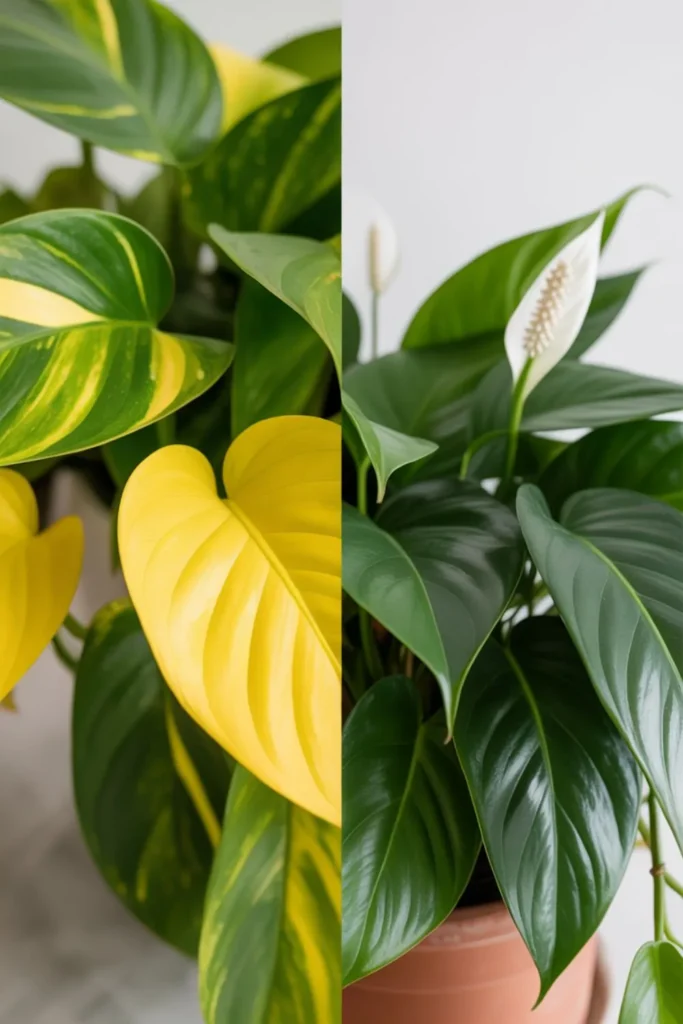
Overwatering in Low Light Conditions
Overwatering problems intensify in low light environments where reduced photosynthesis slows water uptake and root processing. Living room plants often suffer from well-intentioned but excessive watering that creates root rot and fungal issues.
Soil moisture monitoring through finger testing or moisture meters prevents watering mistakes by providing accurate readings of actual plant needs. Deep watering followed by complete drying works better than frequent light watering.
Drainage improvement through quality potting mixes and adequate drainage holes prevents water accumulation that damages root systems. Elevated planters and drainage saucers protect furniture while supporting plant health.
Inadequate Light Assessment
Light level misunderstanding leads to inappropriate plant selection and subsequent plant decline. Living room lighting varies dramatically throughout single spaces, requiring careful assessment before plant placement decisions.
Light meter measurements provide objective data about actual conditions rather than subjective impressions. Smartphone light meter apps offer convenient measurement tools for determining optimal plant placement.
Seasonal light changes affect plant performance as sun angles and daylight hours shift throughout the year. Summer success doesn’t guarantee winter survival without understanding seasonal variations.
Neglecting Plant Size Potential
Mature size planning prevents overcrowding issues and design problems as plants grow beyond their initial proportions. Living room layouts must accommodate adult plant sizes rather than nursery specimens.
Growth rate awareness helps homeowners plan long-term arrangements that remain functional and attractive as plants mature. Fast-growing species may require regular pruning or relocation over time.
Space allocation considers both horizontal spread and vertical growth when positioning plants in living areas. Ceiling height limitations and furniture clearances affect suitable plant selections.
Read More About: Low Light House Plants for Gardens in Dim Spaces
Frequently Asked Questions
What are the best low light house plants for living room corners?
Corner-friendly options include Monstera Deliciosa, Fiddle Leaf Fig, Rubber Trees, and large Snake Plants. These architectural specimens thrive in indirect light while filling vertical space effectively without requiring direct sunlight.
Can living room plants survive with only artificial lighting?
Yes, many low light house plants living room varieties thrive under LED lights and fluorescent fixtures running 12-16 hours daily. ZZ Plants, Pothos, and Chinese Evergreens perform exceptionally well in windowless living rooms with adequate artificial illumination.
How many plants do I need for air purification in my living room?
NASA research suggests one large plant or 2-3 smaller specimens per 100 square feet provides meaningful air cleaning benefits. Peace Lilies, Snake Plants, and Spider Plants offer excellent air purification for typical living room sizes.
Which living room plants are safe for homes with pets and children?
Pet-safe options include Spider Plants, Boston Ferns, Parlor Palms, Prayer Plants, and most fern varieties. Always verify plant toxicity through ASPCA databases before introducing new species to family homes.
How do I style plants in a small living room without overcrowding?
Focus on vertical growing with tall, narrow plants like Snake Plants or trailing species in hanging planters. Multi-level plant stands and corner arrangements maximize green impact while preserving floor space for furniture and movement.
What’s the biggest mistake people make with living room plants?
Overwatering represents the most common error, especially in low light conditions where plants process water slowly. Living room plants typically need watering every 10-14 days rather than weekly schedules appropriate for high-light environments.
Conclusion
Transforming your living room into a lush, sophisticated sanctuary with low light house plants living room specialists creates the perfect blend of natural beauty and modern living convenience. These resilient plant varieties offer endless possibilities for personalizing your most-used space while requiring minimal expertise and maintenance efforts. From dramatic Monstera Deliciosa specimens that command attention in empty corners to elegant Peace Lilies that purify your air while adding flowering beauty, there’s a perfect shade-tolerant option for every living room style and lifestyle need.
The secret to living room plant success lies in understanding that low light adaptation actually makes these plants more suitable for busy modern households than their high-maintenance, sun-loving counterparts. Start with proven performers like Snake Plants, ZZ Plants, or Rubber Trees to build your confidence, then gradually expand your collection with specialized varieties that match your personal style preferences. Remember that proper placement, appropriate watering techniques, and occasional dusting matter more than perfect lighting conditions, these plants have evolved specifically to thrive in the exact indoor conditions your living room naturally provides.

